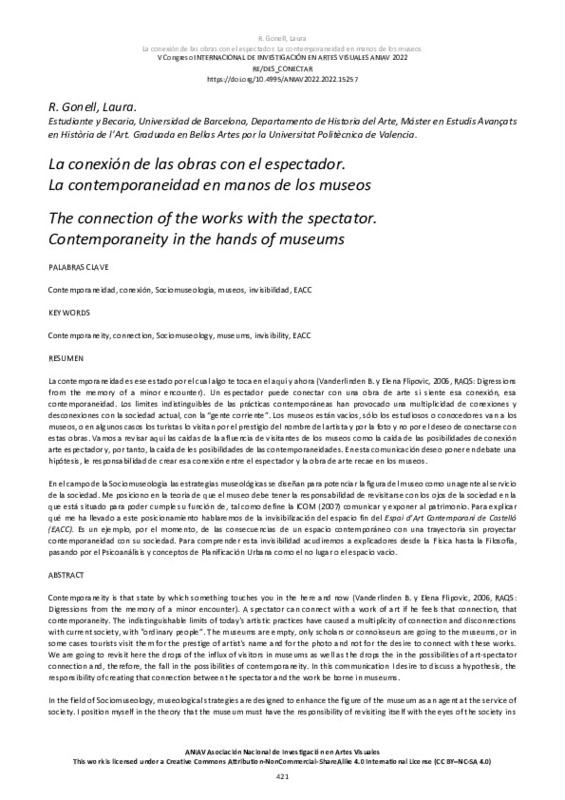|
Resumen:
|
[EN] Contemporaneity is that state by which something touches you in the here and now (Vanderlinden B. y Elena Flipovic, 2006, RAQS:
Digressions from the memory of a minor encounter). A spectator can connect with a work ...[+]
[EN] Contemporaneity is that state by which something touches you in the here and now (Vanderlinden B. y Elena Flipovic, 2006, RAQS:
Digressions from the memory of a minor encounter). A spectator can connect with a work of art if he feels that connection, that
contemporaneity. The indistinguishable limits of today's artistic practices have caused a multiplicity of connection and disconnections
with current society, with "ordinary people”. The museums are empty, only scholars or connoisseurs are going to the museums, or in
some cases tourists visit them for the prestige of artist's name and for the photo and not for the desire to connect with these works.
We are going to revisit here the drops of the influx of visitors in museums as well as the drops the in the possibilities of art-spectator
connection and, therefore, the fall in the possibilities of contemporaneity. In this communication I desire to discuss a hypothesis, the
responsibility of creating that connection between the spectator and the work be borne in museums.
In the field of Sociomuseology, museological strategies are designed to enhance the figure of the museum as an agent at the service of
society. I position myself in the theory that the museum must have the responsibility of revisiting itself with the eyes of the society in s located which is located, to fulfil its function of defined by ICOM (2007) as communicating and exhibiting heritage. To explain what has
led me to this position, we will talk about the invisibility of the physical space of the Espai d’Art Contemporani de Castelló (EACC). It is
an example, at this moment, of the consequences of a contemporary art’s space with a trajectory without projecting contemporaneity
with its society. To understand this invisibility, we will turn to explanations from Physics to Philosophy, passing through Psychoanalysis
and Urban Planning concepts such as non-place or empty space.
[-]
[ES] La contemporaneidad es aquel estado por el cual una cosa te toca en el aquí y el ahora. Una obra de arte tiene muchas contemporaneidades, o mejor dicho el espectador puede verla contemporánea o no depende de su conexión ...[+]
[ES] La contemporaneidad es aquel estado por el cual una cosa te toca en el aquí y el ahora. Una obra de arte tiene muchas contemporaneidades, o mejor dicho el espectador puede verla contemporánea o no depende de su conexión con ella. El límite indistinguible de la contemporaneidad nos ha llevado a una desconexión del arte que llaman contemporáneo con la gente de a pie. Los museos se vacían, sólo van eruditos o los conocedores de las obras. En esta ponencia deseo llevar el debate de la función social del museo. El museo como agente responsable de llevar la cultura a la sociedad pero responsable también de dejar que esa sociedad modifique lo que se puede llamar cultura. ¿Han sido los agentes del mercado del arte los responsables de desconectar el arte de la sociedad en la que se encuentra? Hablaremos de la invisibilización del edificio del Espai d'Art Contemporani de Castelló para sus vecinos como un ejemplo de las consecuencias de un espacio contemporáneo sin contemporaneidad con su sociedad. De cómo un espacio físico no es reconocido como contenedor de experiencias culturales contemporáneas, sino desconectado de la contemporaneidad de los Castellonenses. Este ejemplo nos ayudará a llevar el debate de las responsabilidades en la producción de contemporaneidad de los artistas hacia los museos o instituciones artísticas que los albergan. El artista visual no tiene porqué estar conectado con la sociedad que le envuelve y tal vez tampoco sus obras, pero los museos, espacios físicos que ocupan un lugar dentro de una comunidad y sociedad y que no tienen en sus condiciones físicas el moverse, tienen la responsabilidad de saber qué sociedad le envuelve y hacerse contemporáneo a ella, sea la obra de por sí contemporánea o no.
[-]
|








